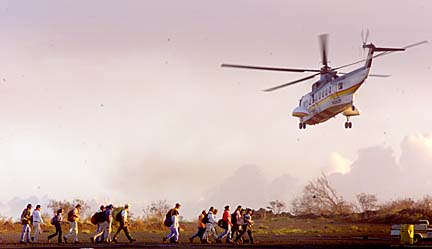
DEAN SENSUI / DSENSUI@STARBULLETIN.COM
Workers march out to the flight line at Maui's Puunene heliport to catch one of several Sikorsky helicopters shuttling workers to Kahoolawe every day. Cleanup operations on the island have been conducted by private contractors, involving up to 400 people, for the past five years.
Navy’s Kahoolawe
cleanup nears finishThe state will need to apply
for limited funds to clear any
ordnance after next March
KAHOOLAWE >> No federal money will be available to continue the cleanup of Kahoolawe once the decade-old $460 million appropriation runs out early next year, the Navy's Hawaii region commander said yesterday.
"The state can petition the federal government through the Congress for more money," said Rear Adm. Barry McCullough, commander of Navy Region Hawaii.
McCullough said the Navy is "committed to coming back and removing previously undetected unexploded ordnance" even after it returns control to the state on Tuesday. In addition, McCullough said the Navy will place the 11-mile-long island, six miles southwest of Maui, in the defense environmental restoration program.
However, McCullough acknowledged that Kahoolawe will have to compete with other sites for the limited money the Navy uses for cleanup operations.
For seven decades, the military bombarded the island with rockets and other weapons in its use as a target range. In 1990, President Bush ended the use of the island as a weapons range. Kahoolawe has been on the National Register of Historic Places since 1981.
In July 1998, contractor Parsons-UXB began the cleanup, which the Navy says is the largest and longest unexploded-ordnance clearance project ever.
As of Oct. 31, the Navy said 20,053 acres of the island's 28,788 acres have been cleared of unexploded ordnance. Civilian workers and ordnance specialists used metal detectors and magnetic devices to pick up any scrap metal -- ordnance, shrapnel and target vehicles -- found on the surface of the island.
In addition, on 2,583 acres, ordnance disposal teams dug as deep as four feet to excavate debris.
"The focus was on the most contaminated areas first and the areas most used by the public," said Tom McCabe, program manager for Parsons-UXB.
McCullough estimated 2,600 acres were left alone since they consisted of steep ravines, gullies and gulches, areas the Navy deemed unsafe for excavation work.
DEAN SENSUI / DSENSUI@STARBULLETIN.COM
The Thermal Processing Unit at Kahoolawe bakes suspect materials at 650 degrees Fahrenheit to ensure that there is no explosive residue remaining on scrap metals that are eventually shipped off the island. Some of the material ends up as nothing more than molten aluminum.
Although the Navy officially is to end its work and turn control of the island over to the state on Tuesday, it will work through March 12 to remove almost all structures it built on the island. It will leave behind a cluster of buildings at Smuggler's Cove and helipads.
The last sweep for unexploded ordnance will take place in early January. Between now and March the Navy will look for unexploded ordnance and ignore scrap metal. The Navy estimated that will involve an additional 810 acres. As of last month the Navy had collected 8.9 million pounds of scrap metal, which was hauled off the island and recycled.
McCullough feels the Navy has fulfilled its commitment as required by federal law and a memorandum it signed with the state and the Kahoolawe Island Reserve Commission.
The Navy one-star admiral said he understands what Kahoolawe means to native Hawaiians and why some groups may want the Navy to do more.
"I can understand why the people of Hawaii would think we're abandoning it, but the truth of the matter is that we're not," he said.
Some native Hawaiians like Donna Simpson, president of the Kaohana O Kahikinui homestead on Maui, agree.
"The wheels are in motion," said Simpson, 54, who has worked on the cleanup project for the past five years. "The end of the project is near. For me, my children will be able to come here, and I will be able to hold my head up high for what I did."

